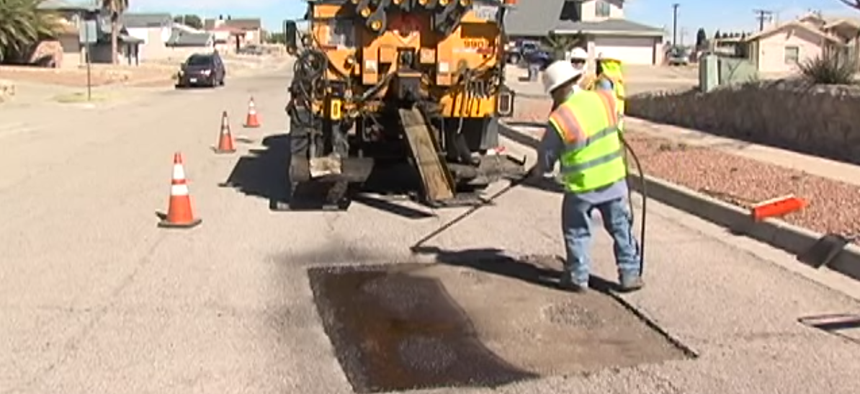El Paso Makes Filling Potholes Look So Easy

An El Paso work crew repairs a pothole on a residential street. City of El Paso / YouTube
Winter-weary drivers may not want to watch this.
Compared to colder-weather jurisdictions that endure tough annual freeze-thaw cycles, heavy salting and snow plowing that can chew up roadway surfaces, El Paso might not be the best place to demonstrate how to fill a pothole.
Still, just like everyone else, drivers in this West Texas border city encounter them and the city fixes them.
In this newly uploaded video produced by the city, an El Paso public works team deployed to tidy residential neighborhood under blue skies with palm trees in the background, show how they go about repairing a pothole, neatly cutting the roadway around the pothole and square-away the edges, “because it looks a lot nicer,” one of the work crew members says.
State and local transportation departments in parts of the nation that have been battered by a wicked winter season—think New England, the Mid-Atlantic, the Great Lakes and Midwest—may not have the luxury of squaring off pothole repairs.
Sometimes, road crews only have time—or resources—to simply throw some asphalt into the hole with a shovel and hope that traffic smooths it out. Sometimes, it’s too cold to do full repairs on a pothole.
In Knoxville, Tennessee, road crews will sometimes use a “cold patch” as a temporary until hot asphalt becomes more available as temperatures warm up, the Knoxville News Sentinel reported this week.
It’s been a challenging winter for sure. Just look at the pothole repair challenge in Boston, which is still digging out from a succession of winter snow storms.
Or take a look at the heavily potholed state of Michigan, where Gov. Rick Snyder is asking voters to approve a ballot initiative to raise the state’s sales tax to fund road repairs. (There’s no Plan B if the proposal fails, Snyder has said.)
There’s no shortage of roads that need repair in Michigan.
As MLive.com pointed out this week, 38 percent of all “federal aid” roads—major state and county roads and some primary city streets—got a poor rating according to preliminary data from the Transportation Assets Management Council:
The pavement condition of those roads—which carry the bulk of Michigan traffic—have steadily deteriorated over the past decade, dropping from 89 percent fair or good in 2003 to 62 percent last year.
At the same time, the volume of road miles in poor condition has more than tripled, jumping from 11 percent to the aforementioned 38 percent. Just last year, 3,470 additional lane miles fell into the poor category, according to TAMC, the largest jump of its kind in seven years.
"The concern there is the cost of improving a system that has that many road sections in poor condition," said Roger Safford, who chairs the council and works as a regional engineer MDOT. "Historically, it costs about four or five times as much to fix a poor road as it does to keep a road in good or fair condition."
Check out just how poor Michigan’s roads are from this interactive map from TAMC.






